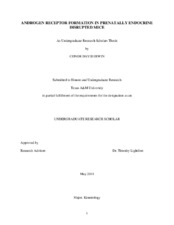| dc.description.abstract | Inactivity is one of the largest detriments in our society today. It has been estimated that about $434 billion are spent on inactivity related health problems in the United States per year (1). This dollar amount is only exceeded in gravity by the death toll, with more than 250,000 deaths per year directly attributing to physical activity (2). These alarming statistics have directed our lab into researching genetic factors contributing to physical activity. A current proposed mechanism contributing to physical activity suggests that androgen receptors are key mediators in activity regulation (3,4). Current literature suggests that certain chemicals, like Benzyl butyl phthalate (BBP), disrupts androgen receptor formation prenatally (5, 6) and we are hypothesizing that this androgen receptor malformation may decrease physical activity after birth. Therefore, the purpose of this study is to explore the relationship between endocrine disruptors given prenatally, androgen receptor formation, and physical activity. | en |


